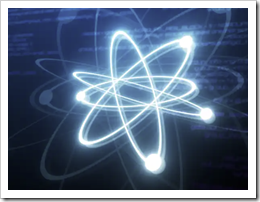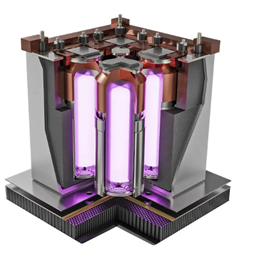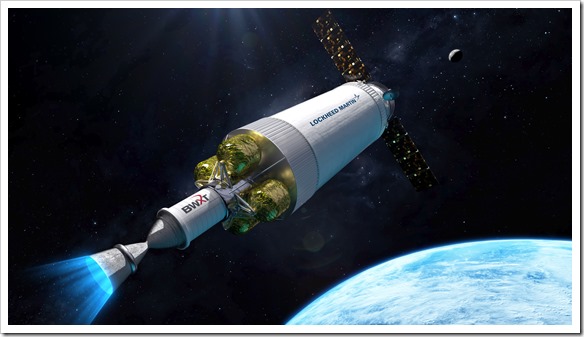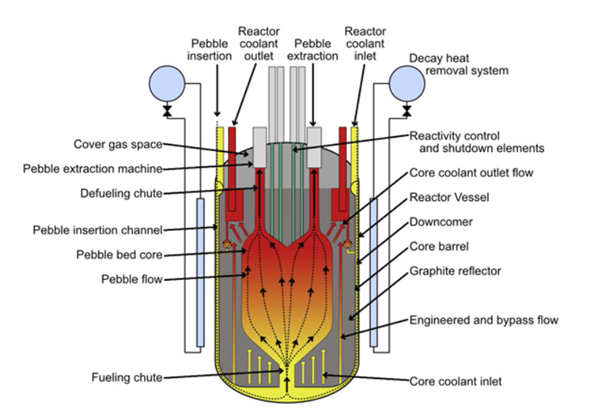- Nuclear Power for Cargo Ships on Earth and Rockets to Mars
- BWXT to Provide Nuclear Reactor Engine and Fuel for DARPA Space Project
- NASA Selects Zeno Power Radioisotope Power System for Lunar Applications
- Maritime / UK Gen IV Reactor Developer Signs Agreement For Shipping Study
- Kairos Submits Construction License Application to NRC
- UK Fusion Company To Work With Japan’s Sumitomo
Nuclear Power for Cargo Ships on Earth and Rockets to Mars
- DARPA Nuclear Thermal Rocket Contracts Awards to Lockheed, BWXT. Kicks Off Design, Fabrication for DRACO Experimental Nuclear Thermal Rocket (NTR) Vehicle
Artist concept of Demonstration for Rocket
to Agile Cislunar Operations (DRACO) spacecraft (image: DARPA)
DARPA, in collaboration with NASA, announced progress toward the goal of the world’s first in-orbit demonstration of a nuclear thermal rocket (NTR) engine via the Demonstration Rocket for Agile Cislunar Operations aka DRACO.
This week DARPA inked an agreement with Lockheed Martin for the company to begin work on the fabrication and design of the experimental NTR vehicle (X-NTRV) and its engine. BWX Technologies (BWXT), one of Lockheed Martin’s partners in the effort, will develop the nuclear reactor and fabricate the HALEU fuel supplied by the Department of Energy.
The DRACO program, based on $449 million in federal funding, takes advantage of the nation’s early investments in nuclear thermal technology via the previous Nuclear Engine for Rocket Vehicle Applications (NERVA) program, but with a new fuel option that presents fewer logistical hurdles.
DARPA is using high-assay low-enriched uranium (HALEU) fuel, made possible via National Security Presidential Memorandum 20 (NSPM-20), which updated U.S. policy for the launch of space nuclear power and propulsion. As an additional safety measure, DARPA will engineer the system so that the engine’s fission reactor will stay turned off until it reaches its designated orbit.
The U.S. Space Force will provide the launch vehicle that will take the X-NTRV into space in 2027. The Department of Energy will provide HALEU metal, to be processed into fuel by the performer.
“The DRACO program aims to give the nation leap-ahead propulsion capability,” said Dr. Tabitha Dodson, program manager for the effort.
“An NTR achieves high thrust similar to in-space chemical propulsion but is two-to-three-times more efficient. With a successful demonstration, we could significantly advance humanity’s means for going faster and farther in space and pave the way for the future deployment for all fission-based nuclear space technologies.”
The Demonstration Rocket for Agile Cislunar Operations (DRACO) program is a three-phase program to develop and test nuclear thermal propulsion technology in space. The goal is to demonstrate a nuclear thermal rocket (NTR) in orbit. The technology could be used to transport astronauts to Mars and beyond, and enable fast-transit missions to Mars. The plan is to send the DRACO test vehicle into space and run the nuclear engine in 2027.
Nuclear propulsion systems can produce vehicle speeds that are 30 to 70% higher than chemical propulsion systems. For example, the Orion spacecraft flew by the moon at about 5,000 mph, but with a nuclear-powered rocket engine, it could have flown as fast as 6,500 mph to 8,500 mph.
& & &
BWXT to Provide Nuclear Reactor Engine and Fuel for DARPA Space Project
- DRACO Program Will Demonstrate Nuclear Power’s Ability to Propel Spacecraft
 BWX Technologies, Inc. (NYSE: BWXT) announced that its reactor and fuel will be key components in the world’s first demonstration spacecraft using nuclear thermal propulsion.
BWX Technologies, Inc. (NYSE: BWXT) announced that its reactor and fuel will be key components in the world’s first demonstration spacecraft using nuclear thermal propulsion.
Working as part of a team led by Lockheed Martin, BWXT Advanced Technologies LLC will complete final design of the nuclear reactor, manufacture the reactor’s hardware and fuel, assemble the components and deliver the fueled reactor as a complete subsystem for integration into the Defense Advanced Research Projects Agency’s (DARPA) Demonstration Rocket for Agile Cislunar Operations (DRACO). Work on this program will be conducted primarily at BWXT’s Mt. Athos Road complex near Lynchburg, Virginia.
The reactor’s energy will enable propulsion that allows DRACO to maneuver through space with great speed and agility for an extended period of time. This nuclear thermal propulsion system is designed to use High Assay Low Enriched Uranium (HALEU) fuel to rapidly heat a super-cold gas, such as liquid hydrogen. As the gas is heated, it expands quickly and creates thrust to move the spacecraft more efficiently than typical chemical combustion engines. The objective is to radically shorten the transit time from Earth to Mars.
The spacecraft is targeted for a 2027 launch from Earth in “cold” status (meaning that the reactor is turned off as a part of launch safety protocols) by a conventional rocket, and then the reactor will be powered on once the spacecraft attains an appropriate location above low earth orbit. The DRACO development is to culminate with a flight test of the nuclear-thermal engine.
The demonstration spacecraft will orbit at an altitude between 435 and 1,240 miles. DARPA said that this orbit is high enough to ensure that that the test vehicle stays in orbit for more than 300 years, or long enough for radioactive elements in the reactor fuel to decay to safe levels.
& & &
NASA Selects Zeno Power Radioisotope Power System for Lunar Applications
 NASA announced that a team led by Zeno Power, a developer of commercial radioisotope power systems (RPS), has been awarded a $15 million Tipping Point award to develop an americium-241 (Am-241) radioisotope Stirling generator (RSG) for lunar surface missions.
NASA announced that a team led by Zeno Power, a developer of commercial radioisotope power systems (RPS), has been awarded a $15 million Tipping Point award to develop an americium-241 (Am-241) radioisotope Stirling generator (RSG) for lunar surface missions.
The team for the program, called Harmonia, includes Blue Origin, Intuitive Machines Inc. (Nasdaq: LUNR, LUNRW), NASA Glenn Research Center, NASA Marshall Flight Center, Sunpower Inc., and the University of Dayton Research Institute.
Operations during the two-week lunar night and in permanently shadowed regions (PSRs) are a challenge due to the extreme conditions in these environments. The RSG developed through this Tipping Point initiative could enable lunar assets to survive and operate during the lunar night – extending mission durations from two weeks to several years. It could also enable long-duration exploration of scientifically important PSRs located at the lunar south pole. Harmonia’s goal is to develop flight-ready technology for a 2027 lunar surface demonstration.
Building on decades of NASA Stirling RPS research, Zeno and Blue Origin will collaborate with NASA Glenn Research Center to scale and optimize the integration of Stirling convertors into a novel RSG design. The optimized RSG will increase the system efficiency three times as compared to legacy radioisotope power systems – yielding state-of-the-art RSG technology for broad use by NASA and commercial space customers.
NASA’s Artemis missions are intended to usher in the next era of human space exploration, planetary science, and international cooperation. To operate in the harsh environment, lunar missions need a reliable long-duration energy source such as radioisotope energy.
Harmonia could enable NASA and its partners to establish a sustainable lunar presence with robots and astronaut crews.
An RPS is a compact power source that converts heat generated by the decay of radioisotopes into a constant supply of clean energy. RPSs for space applications have historically been powered by plutonium-238 from the U.S. Department of Energy, with a fuel supply chain sufficient to power NASA’s marquee missions.
Using materials science and nuclear fuel manufacturing innovations, Zeno’s novel design provides additional fuel options by using alternative radioisotopes that are currently categorized as nuclear waste. Americium-241 is a long-lived isotope with favorable thermal and radiation profiles that can complement current plutonium-238 based RPSs and enable not-yet-pursued mission classes.
“This project can demonstrate how broadly applicable this fuel source could be in establishing a plug-and-play interoperable system, whether that be for a lunar lander, exploration rover, or crewed activities,” said Zeno Vice President of Engineering Lindsey Boles.
“Given the predictable thermal output and long half-life of this isotope, our systems can be used sustainably on the lunar surface for decades.”
Through the Tipping Point solicitation, NASA’s Space Technology Mission Directorate seeks private industry-developed space technologies that can foster the development of commercial space capabilities and benefit future NASA missions. The program furthers the technological readiness of awardees to provide services for new government and commercial purposes, including Earth-bound applications, bringing them from the laboratory to initial demonstration.
About Zeno
Zeno Power is a leading developer of commercial radioisotope power systems. The company, founded in 2018, has offices in Washington, D.C., and Seattle, Wash., and recently signed a $30 million agreement with the U.S. Department of Defense to demonstrate a flight-ready radioisotope powered satellite by 2025.
About Americium-241
Americium-241 is used as an ionization source in smoke detectors, and most of the americium made each year is used in this way. It’s also used as a neutron source in non-destructive testing of machinery and equipment, and as a thickness gauge in the glass industry.
The radiation from americium-241 can be stopped by a piece of paper or a few centimeters of air and cannot penetrate the human epidermis. A 2001 NRC study found that people with two smoke detectors in their homes receive less than 0.002 millirems of radiation dose each year.
& & &
Maritime / UK Gen IV Reactor Developer Signs Agreement For Shipping Study
(NucNet) Newcleo, a developer of a Gen IV nuclear reactor, has signed a cooperation agreement with Italian shipbuilding major Fincantieri and the RINA classification society to carry out a feasibility study into nuclear applications to the shipping industry.
 London-based Newcleo is developing lead-cooled fast reactor (LFR) technology that uses nuclear waste as fuel. Newcleo said the deployment of its LFR for maritime propulsion would involve placing a closed mini reactor on vessels as a small nuclear battery producing a 30 MW electric output.
London-based Newcleo is developing lead-cooled fast reactor (LFR) technology that uses nuclear waste as fuel. Newcleo said the deployment of its LFR for maritime propulsion would involve placing a closed mini reactor on vessels as a small nuclear battery producing a 30 MW electric output.
The reactor, as it is being designed, would require infrequent refueling, only once every 10-15 years, very limited maintenance, and easy replacement at end of life.
Newcleo chairman and chief executive officer Stefano Buono said Fincantieri and RINA are two leaders in the shipping sector, and “combining their expertise with our technology innovation can bring a real solution to the issue of carbon emissions in maritime transport”.
The firm said earlier this year it is aiming to commission a 30 MW demonstrator and pilot nuclear power plant for innovative fuels by 2030.
A recent study by the American Bureau of Shipping (ABS) concluded that the adoption of advanced nuclear reactors onboard a large containership would eliminate the need for refueling of the vessel during its entire 25-year lifespan.
ABS chairman and chief executive officer Christopher Wiernicki said the study shows why the shipping industry cannot afford to ignore the vast potential offered by nuclear propulsion both in terms of emissions reduction and operational efficiency.
A study commissioned by the American Bureau of Shipping (ABS) has explored the potential of advanced nuclear technology for commercial marine propulsion. According to the study, the use of two 30 MW fast reactors on the container carrier would likely increase cargo capacity and operational speed while eliminating the need for refueling during its entire 25-year lifespan.
The company said that the shipping industry, which carries 90% of the world’s goods, recently approved new targets for greenhouse gas emission reduction, to reach net-zero GHG emissions by or around 2050.
& & &
Kairos Submits Construction License Application to NRC
(WNN) Kairos Power has submitted an application to the US Nuclear Regulatory Commission (NRC) for permission to build the Hermes 2 plant next to the Hermes molten salt test reactor it plans to build at Oak Ridge, Tennessee. The two-unit demonstration plant would produce and sell electricity. Hermes 2 will be built next to the Hermes non-power demonstration plant. (Technical Briefing – PDF file)
Conceptual image Kairos Power advanced reactor using TRISO fuel”
Image: Kairos Power as submitted to US NRC
The NRC is now assessing the application, which was submitted by Kairos on July 14th, to determine if it is acceptable and complete enough to begin the formal technical review process.
In June, the NRC issued a Final Safety Evaluation Report for the company’s application to build the first Hermes molten salt test reactor – a 35 MW (thermal) non-power version of the company’s fluoride salt-cooled high temperature reactor, the KP-FHR, at Oak Ridge. The company expects to receive that construction license later this year. The company will require a separate license to operate the reactor.
Hermes 2 is described by Kairos as being intended to demonstrate the complete architecture of future commercial plants at a smaller scale, building on the learnings from the Hermes reactor. It is composed of two 35 MW (thermal) reactors – each the same size as the original test reactor – sharing a power generation system,
Hermes 2’s objectives would be to further reduce risk on the path to commercializing the KP-FHR technology, demonstrating licensing, construction, operations, training, and decommissioning of a multi-reactor plant to help achieve cost certainty for the first commercial unit.
According to the application document, the earliest start date for construction of Hermes 2 is expected to be July 2025 with the first unit projected to be completed by July 2027 at the earliest and December 2027 at the latest. Construction of the second unit is expected to be completed one year after the first unit. An 11-year operating period is projected for each of the two test reactors.
& & &
UK Fusion Company To Work With Japan’s Sumitomo
- Objective is to ‘jointly design, build and operate’ nuclear plants
 (NucNet) UK-based Tokamak Energy has announced plans to work with Japan’s Sumitomo Corporation on the development, implementation and scaling-up of commercial fusion energy “in Japan and worldwide”.
(NucNet) UK-based Tokamak Energy has announced plans to work with Japan’s Sumitomo Corporation on the development, implementation and scaling-up of commercial fusion energy “in Japan and worldwide”.
The new partnership will see Sumitomo, a multinational company with interests ranging from construction to chemicals, contribute expertise and investment to a series of joint projects with Tokamak Energy focused on the scaling-up and industrialization of the global fusion supply chain.
They will jointly develop early market strategies for Tokamak Energy’s fusion technology in Japan and other nations.
Tokamak Energy said in a statement, “The ultimate aim for both organizations is to jointly design, build and operate fusion power plants at scale.”
The statement said the collaboration will enable Sumitomo Corporation to offer the financing, construction and operation of fusion power plants. Tokamak Energy will accelerate the commercialization and industrialization of its spherical tokamak devices in the late 2030s.
Tokamak Energy is developing a commercial fusion power plant, which it says will generate enough electricity to power 50,000 homes in the 2030s.
The company’s ST-E1 pilot plant is intended to demonstrate the capability of delivering electricity into the grid in the early 2030s and pave the way for globally deployable 500-MW commercial plants that can be built next to large populations and centers of industry where power and heat is needed.
# # #
- SEO Powered Content & PR Distribution. Get Amplified Today.
- PlatoData.Network Vertical Generative Ai. Empower Yourself. Access Here.
- PlatoAiStream. Web3 Intelligence. Knowledge Amplified. Access Here.
- PlatoESG. Automotive / EVs, Carbon, CleanTech, Energy, Environment, Solar, Waste Management. Access Here.
- BlockOffsets. Modernizing Environmental Offset Ownership. Access Here.
- Source: https://energycentral.com/c/ec/nuclear-power-cargo-ships-earth-and-rockets-mars





